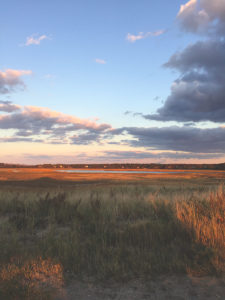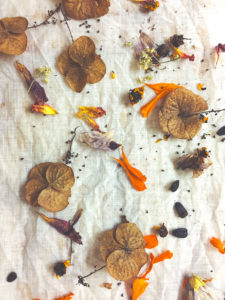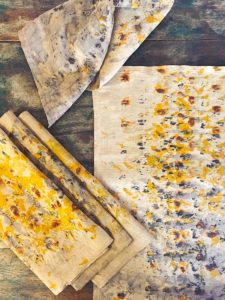
Even in these chilly gray days of November we find color everywhere on the Outer Cape. Marsh and beach grasses are golden fire. Junipers are deep green, their bright berries like tiny punctuation marks in the lush foliage. Scrub oak and pitch pine leaves litter the woods, a russet-colored blanket for winter. The sleeping garden holds color value as well: non-native privet and forsythia offer purple berries and purple leaves. Flower beds, drab from afar, are full of possibilities; they are the story of summer, of seed to stem to seed again.
Ecoprinting is an opportunity to work with these plants in their last hurrah, to walk the woods or your garden and see things differently. Pick up a few leaves from the ground, arrange them on fabric, roll into a bundle, then steam. The heat transfers the pigments and images onto the fabric, creating an ethereal design, an explosion of color and pattern. No need to go out and purchase new linens for the holidays — this can be done on napkins or tablecloths you already own, and it’s perfect for camouflaging linens with spots or stains. Maybe it’s a project that becomes a tradition, imbuing your linens with the landscape, weaving the years like a tapestry.
Coaxing color from plants can be tricky. A few pointers to help with your experiments: natural colors work only with natural fibers. Cotton or linen are best for this project. Also keep in mind size: larger pieces like tablecloths can be folded, but overall your bundled fabric will need to fit inside a stainless-steel pot with a lid.

Dyeing with natural color consists of three steps: scouring, mordanting, and dyeing. Scouring is essentially a super cleanse for your fibers, allowing them to absorb both the mordant and plant color properly. Mordanting, from the French term meaning “to bite,” ensures that the color binds with the fabric. Without a mordant, dyes will simply wash out or fade. For the purpose of this project, the mordant to use with cellulose fibers is aluminum acetate (use aluminum sulfate for silk or protein fibers). Use caution with alum, as it is very powdery and dusty. Don’t use your cookware for natural dyeing — you’ll want to pick up a pot and any other tools at the swap shack.
Scouring
First, weigh your clean, dry fabric.
Place fabric in a large pot with enough water to cover, soak for at least an hour (overnight is best). Make sure fibers can move freely.
Add a tablespoon of a pH-neutral, eco-friendly dish soap per 8 oz. of fabric to the pot.
Place pot over heat, cover, and bring to a very low simmer (about 130 degrees F) for 30 minutes, stirring fibers often.
Allow to cool, then rinse until the water runs clear. Now you’re ready to mordant the fibers.
Mordanting
Fill a bucket with enough water to cover fabric.
Add alum (5 percent of weight of fiber) to a cup.
Slowly add one cup of boiling water to the alum and stir until fully dissolved.
Pour the alum solution into the bucket and stir thoroughly.
Add fabric and stir.
Soak for 45 minutes, stirring often. Remove and rinse. (To reuse your alum bath multiple times, cover with an airtight lid and store. Or water your acid-loving plants with it.)

Dyeing
Squeeze excess liquid from fabric. Lay out on a clean surface.
Gather plant materials and arrange plants on the fabric, keeping in mind what you start with isn’t always what you end up with. The colors shift through the fibers, coalescing into new values — bright here, dark there.
Once you’re happy with the layout, place a small stick on one edge of the fabric and begin rolling the piece, tucking and smoothing things out as you go. (Reminder — this needs to fit in the pot. Fold larger pieces of fabric in halves or quarters before rolling.)
Tie a piece of twine around one end of your bundle and begin wrapping the fabric tightly, tying off at the opposite end.
Place bundle in a large pot in a vegetable steamer. Water level should be low enough so as not to soak the bundles.
Steam with the lid on for an hour, rotating after 30 minutes. Carefully remove from heat and allow to cool.
Untie twine and unroll to reveal a landscape of color and pattern. Remove plant material, rinse and wash in cool water.
Hang to dry, and admire the view. It is the trail through the woods where you walk, a snapshot of what you grew through the year. It is the landscape of the Outer Cape, this place at the edge of the sea.
